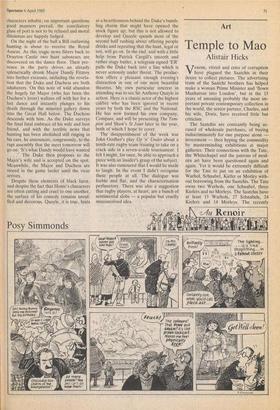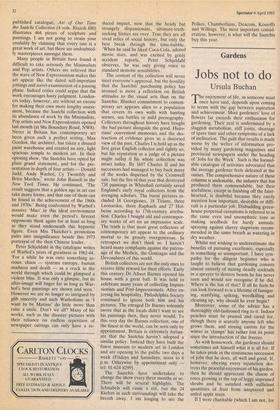Art
Temple to Mao
Alistair Hicks
jenom, vitriol and cries of corruption V have plagued the Saatchis in their desire to collect pictures. The advertising team of the Saatchi brothers has helped make a woman Prime Minister and 'flown Manhattan into London', but in the 15 years of amassing probably the most im- portant private contemporary collection in the world, the senior partner, Charles, and his wife, Doris, have received little but criticism.
The Saatchis are constantly being ac- cused of wholesale purchases, of buying indiscriminately for one purpose alone investment — then hyping the commodity by masterminding exhibitions at major galleries. Their connections with the Tate, the Whitechapel and the patrons of mod- ern art have been questioned again and again. Yet it would be extremely difficult for the Tate to put on an exhibition of Warhol, Schnabel, Kiefer or Morley with- out borrowing from the Saatchis. The Tate owns two Warhols, one Schnabel, three Kiefirs and no Morleys. The Saatchis have at least 15 Warhols, 27 Schnabels, 24 Kiefers and 14 Motleys. The recently
published catalogue, Art of Our Time the Saatchi Collection (4 vols. Rizzoli £80) illustrates 464 pieces of sculpture and paintings. I am not going to strain your credulity by claiming that every one is a great work of art, but there are undoubted- ly masterpieces amongst them.
Many people in Britain have found it difficult to take seriously the Minimalists and Pop artists. Others are relieved that the wave of New Expressionism makes this art appear like the dated self-important jottings and navel-examination of a passing phase. Indeed critics could argue that the work encourages hasty judgment. London- ers today, however, are without an excuse for making their own more lengthy assess- ment, because the Saatchi collection with its abundance of work by the Minimalists, Pop artists and New Expressionists opened last month (at 98a Boundary Road, NW8).' Never in Britain has contemporary art been given such a perfect setting. Max Gordon, the architect, has taken a disused paint warehouse and created an airy, light spacious temple to modern art. In their opening show, 'the Saatchis have opted for plain grand statement, and for the pre- sentation in depth of four artists — Donald Judd, Andy Warhol, Cy Twombly and Brice Marden,' wrote John Russell in the New York Times. He continued, 'The result suggests that a golden age in art can take many forms, and that one of them can be found in the achievement of the 1960s and 1970s.' Being confronted by Warhol's massive 'Mao' in this ideal environment would make even the period's fiercest opponents think again for at least as long as they stand underneath this hypnotic figure. Even Mrs Thatcher's promotion pales into insignificance beside this 1973 portrayal of the then Chinese leader.
Peter Schjeldahl in the catalogue writes of Warhol's years of greatness as 1962-64. 'For a while he was onto something se- rious: chaos — systems entropy, human madness and death — as a crack in the world through which could be glimpsed a violent bliss. It was only a glimpse, but its after-image will linger for as long as War- hol's best paintings are shown and seen.'
However we are no longer so intrigued by glib sincerity and such Warholisms as 'I want to be Matisse' do little more than raise a smile. Don't we all? Many of his works, such as the disaster pictures with their reliance on endless repetition of newspaper cuttings can only have a re- duced impact, now that the heady but strangely dispassionate, ultimate-truth- seeking Sixties are over. True they are all vivid relics of social history, but only the best break through the time-bubble. 'When he said he liked Coca-Cola, adored movie stars, and was excited by grisly accident reports,' Peter Schjeldahl observes, 'he was only giving voice to standard demotic sensibilities.'
The content of the collection will never meet everyone's approval, but the hostility that the Saatchis' purchasing policy has aroused is more a reflection on British attitudes to the visual arts than on the Saatchis. Blanket commitment to contem- porary art appears alien to a population that covers its own walls with hunting scenes, sea battles or mild pornography. Collectors throughout history have bought the bad picture alongside the good. Histo- rians' convenient memories and the des- truction of evidence gives us a distorted view of the past. Charles I is held up as the first great English collector and rightly so, but his reputation as a judge of a picture might suffer if his whole collection was intact today. By 1697 Charles II and his successors had managed to buy back many of the works dispersed by the Cromwell sale, but the fire of that year that destroyed 738 paintings in Whitehall certainly saved England's early royal collectors from the avenging scholars. The burnt pictures in- cluded 18 Georgiones, 18 Titians, three Leonardos, three Raphaels and 27 Hol- beins according to 17th-century attribu- tion. Charles I bought old and contempor- ary works of art on an impressive scale. The truth is that most great collectors of contemporary art appear to the ordinary mortal to be grossly overgenerous. In retrospect we don't think so. I haven't heard many complaints against the patron- age of the Medicis, the Gonzagas and the Devonshires of this world.
British collectors are not the only ones to receive little reward for their efforts. Early this century Dr Albert Barnes opened his house with a great ball. It was held to celebrate many years of collecting Impres- sionists and Post-Impressionists. After en- joying his hospitality, Philadelphia Society continued to ignore both him and his pictures. The enraged Dr Barnes solemnly swore that as the locals didn't want to see his paintings then, they never would. To this very day the Barnes collection, one of the finest in the world, can be seen only by appointment. Britain is extremely fortun- ate that the Saatchis haven't adopted a similar policy. Instead they have built the finest museum to modern art in London and are opening to the public two days a week (Fridays and Saturdays, noon to 6 p.m. Otherwise by appointment only — tel: 01-624 8299).
The Saatchis have undertaken to change the show every three months or so.
There will be several highlights. The Schnabels will cause a stir, but the 24 Kiefers in such surroundings will take the breath away. I am longing to see the Polkes, Chamberlains, Deacons, Kossoffs and Willings. The most important consid- eration, however, is what will the Saatchis buy this year.











































 Previous page
Previous page